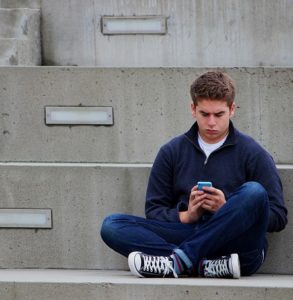The Brain-Changing Power of Conversation
 For parents, childcare providers, and early educators, new research describes a simple and powerful way to build children’s brains: talk with them, early and often. Read more ›
For parents, childcare providers, and early educators, new research describes a simple and powerful way to build children’s brains: talk with them, early and often. Read more ›
 For parents, childcare providers, and early educators, new research describes a simple and powerful way to build children’s brains: talk with them, early and often. Read more ›
For parents, childcare providers, and early educators, new research describes a simple and powerful way to build children’s brains: talk with them, early and often. Read more ›
 Scientists from Stanford University have discovered the brain pathway that directly links a positive attitude with achievement.
Scientists from Stanford University have discovered the brain pathway that directly links a positive attitude with achievement.
Researchers at the Stanford University School of Medicine studied 240 children ages seven to 10 and found that being positive improved their ability to answer math problems, increased their memories and enhanced their problem-solving abilities. They also used MRI brain scans to map the neurological effects of positivity. Read more ›
 Early test scores do not predict future academic growth, according to research from Stanford.
Early test scores do not predict future academic growth, according to research from Stanford.
The research was performed by Sean Reardon, a professor who studies poverty and inequality in education at the university, and based upon analysis of test scores of students in grades 3-8 at 11,000 districts across the country. Read more ›
 A study published in December in the Journal of Adolescence, suggests that altruistic behaviors, including large and small acts of kindness, may raise teens’ feelings of self-worth. However, not all helping behaviors are the same. The researchers found that adolescents who assisted strangers reported higher self-esteem one year later. Read more ›
A study published in December in the Journal of Adolescence, suggests that altruistic behaviors, including large and small acts of kindness, may raise teens’ feelings of self-worth. However, not all helping behaviors are the same. The researchers found that adolescents who assisted strangers reported higher self-esteem one year later. Read more ›
 A recent study, published in the Journal of the Society for Social Work and Research, suggests that different groups of people also talk about depression differently. In particular, poorer black kids discuss their feelings of depression differently than other demographic groups. Read more ›
A recent study, published in the Journal of the Society for Social Work and Research, suggests that different groups of people also talk about depression differently. In particular, poorer black kids discuss their feelings of depression differently than other demographic groups. Read more ›
 Researchers found that teens who spent a lot of time in front of screen devices — playing computer games, using more social media, texting and video chatting — were less happy than those who invested time in non-screen activities like sports, reading newspapers and magazines, and face-to-face social interaction. The happiest teens used digital media for less than an hour per day. But after a daily hour of screen time, unhappiness rises steadily along with increasing screen time. Read more ›
Researchers found that teens who spent a lot of time in front of screen devices — playing computer games, using more social media, texting and video chatting — were less happy than those who invested time in non-screen activities like sports, reading newspapers and magazines, and face-to-face social interaction. The happiest teens used digital media for less than an hour per day. But after a daily hour of screen time, unhappiness rises steadily along with increasing screen time. Read more ›
 The ability to exercise self-control — even with a specific, self-imposed goal in mind — is tough, even as it develops with age. New research from the Harvard Graduate School of Education illustrates just how precarious willpower can be for young people: Middle school students who want to achieve a goal and who actively agree to suffer a consequence if they don’t achieve it may still be unable to change their counterproductive behaviors. It’s a reminder for teachers that simply encouraging students to “stay focused” may not help those students cultivate positive habits. Read more ›
The ability to exercise self-control — even with a specific, self-imposed goal in mind — is tough, even as it develops with age. New research from the Harvard Graduate School of Education illustrates just how precarious willpower can be for young people: Middle school students who want to achieve a goal and who actively agree to suffer a consequence if they don’t achieve it may still be unable to change their counterproductive behaviors. It’s a reminder for teachers that simply encouraging students to “stay focused” may not help those students cultivate positive habits. Read more ›
 Human Rights Campaign (HRC) advocates for LGBTQ equality and educates the public about LGBTQ issues. Being supported at home, in school and in the community is important for all children and youth – especially lesbian, gay, bisexual, transgender and questioning/queer (LGBTQ) youth. From creating an inclusive learning environment for students – whether a student is in the process of transitioning or she has two moms – to understanding the challenges and resiliency of LGBTQ youth, HRC provides a wealth of resources for supporting LGBTQ youth. Read more ›
Human Rights Campaign (HRC) advocates for LGBTQ equality and educates the public about LGBTQ issues. Being supported at home, in school and in the community is important for all children and youth – especially lesbian, gay, bisexual, transgender and questioning/queer (LGBTQ) youth. From creating an inclusive learning environment for students – whether a student is in the process of transitioning or she has two moms – to understanding the challenges and resiliency of LGBTQ youth, HRC provides a wealth of resources for supporting LGBTQ youth. Read more ›
 It’s a familiar sight in the majority of young families: young children bent over a screen for hours, texting or gaming, lost in a digital world.
It’s a familiar sight in the majority of young families: young children bent over a screen for hours, texting or gaming, lost in a digital world.
Many parents worry, how much screen time is too much? Read more ›